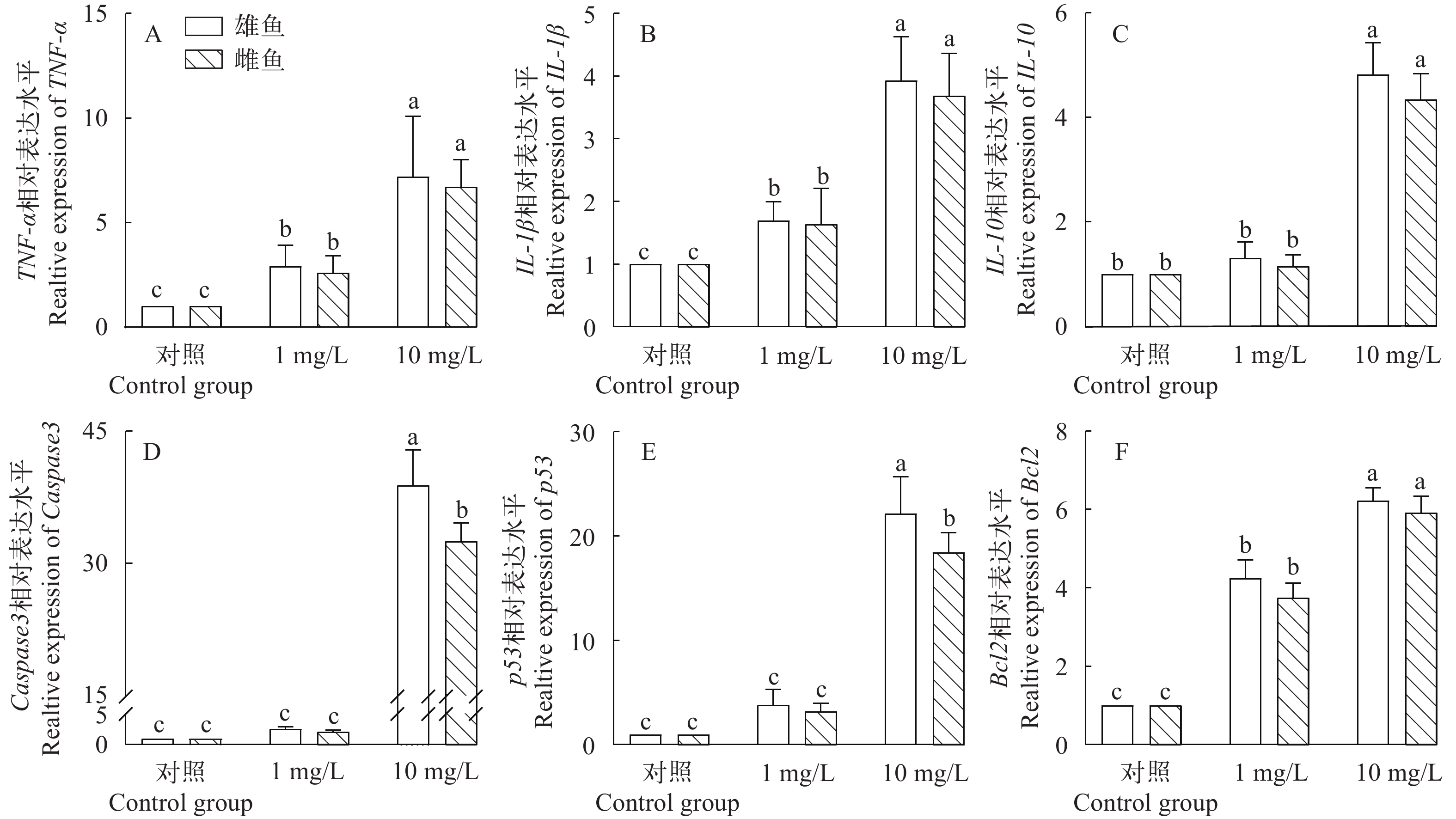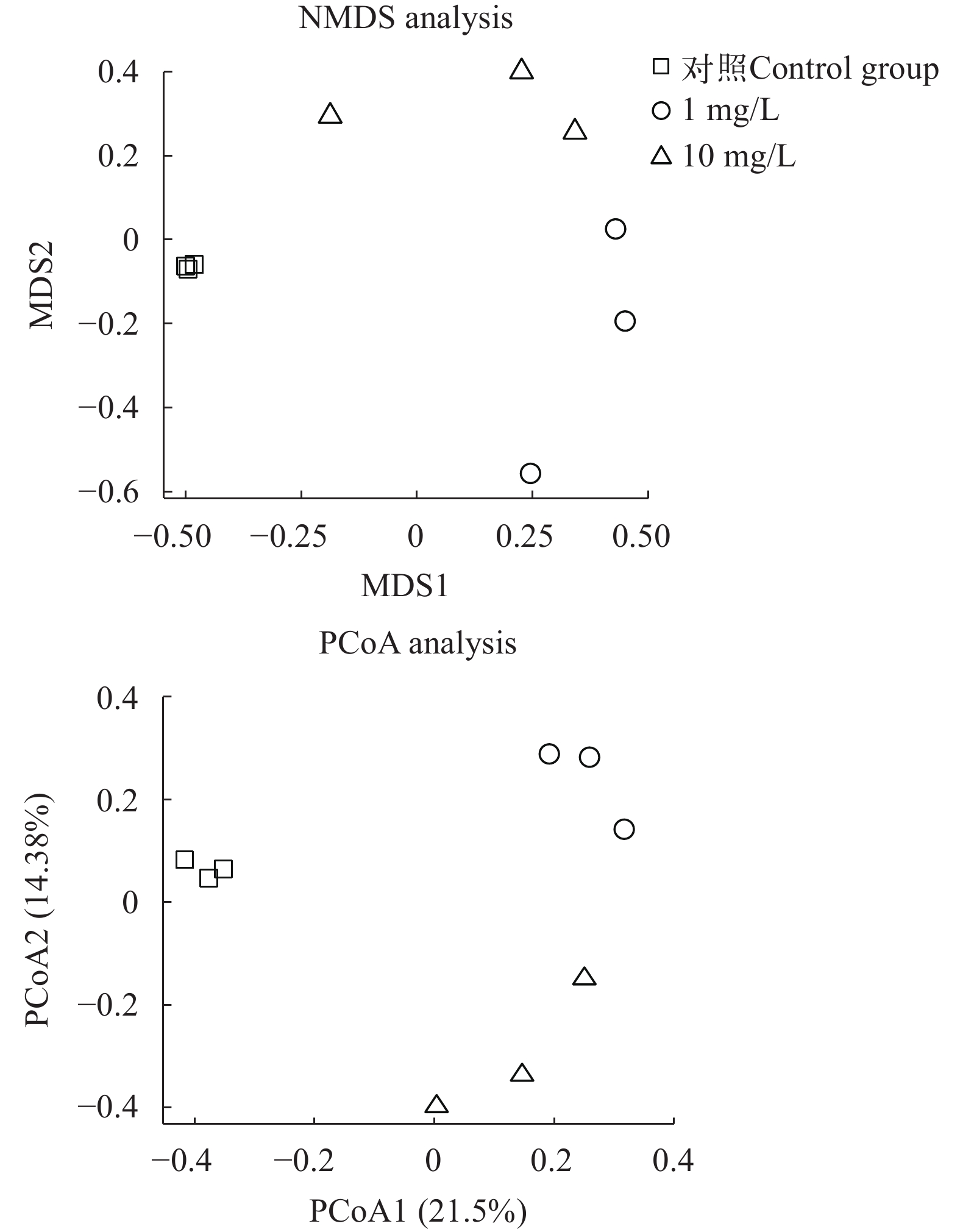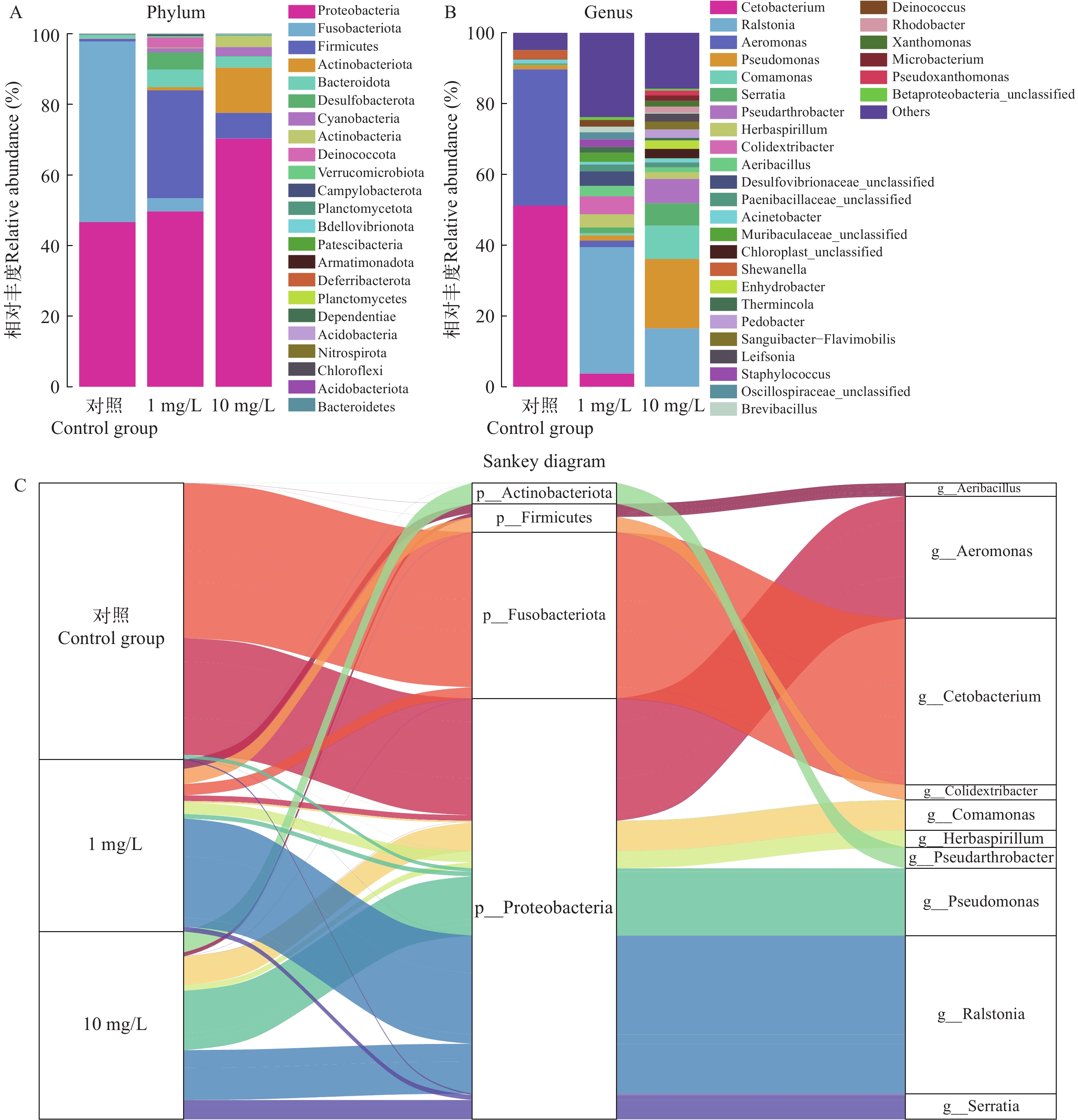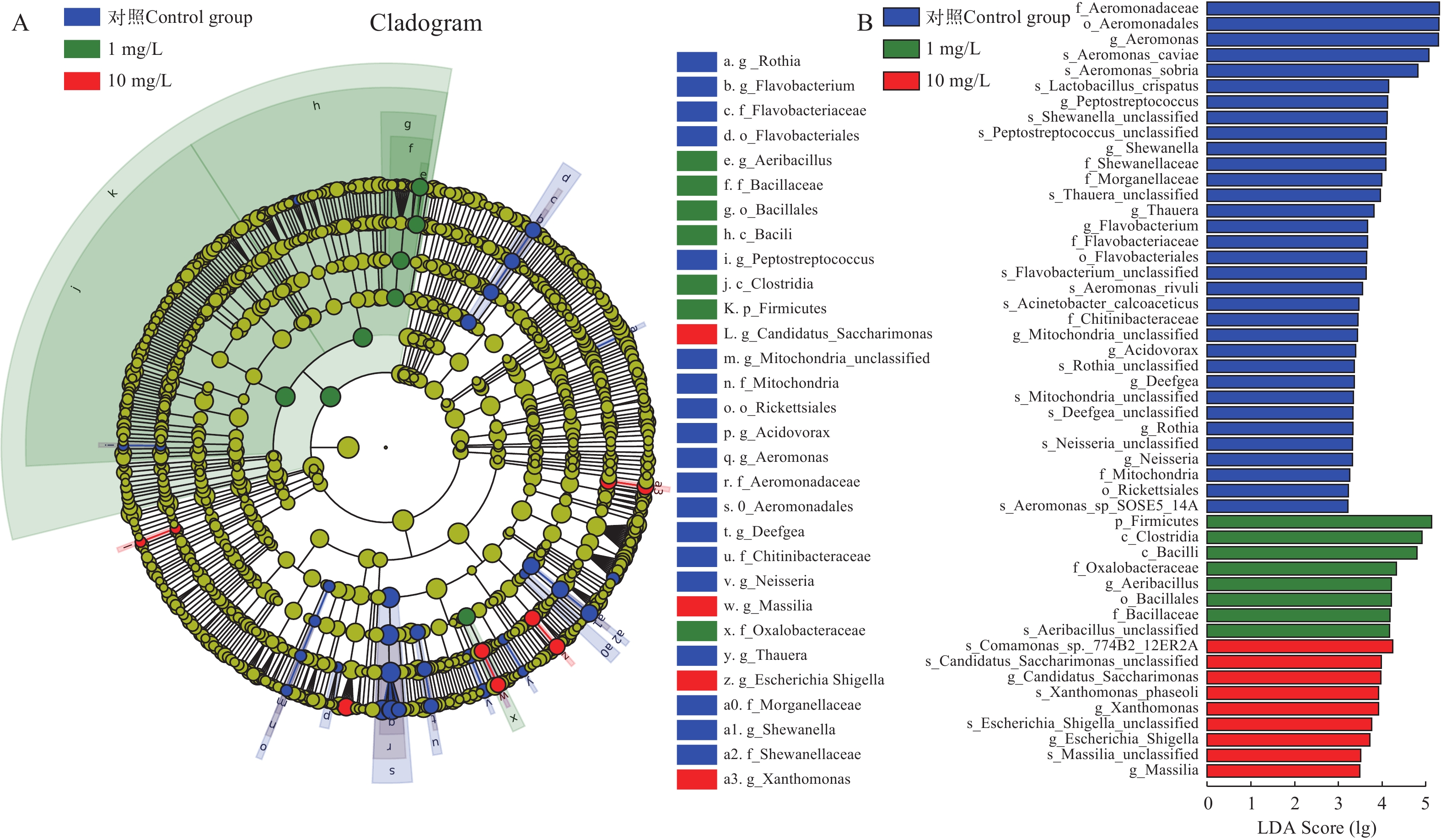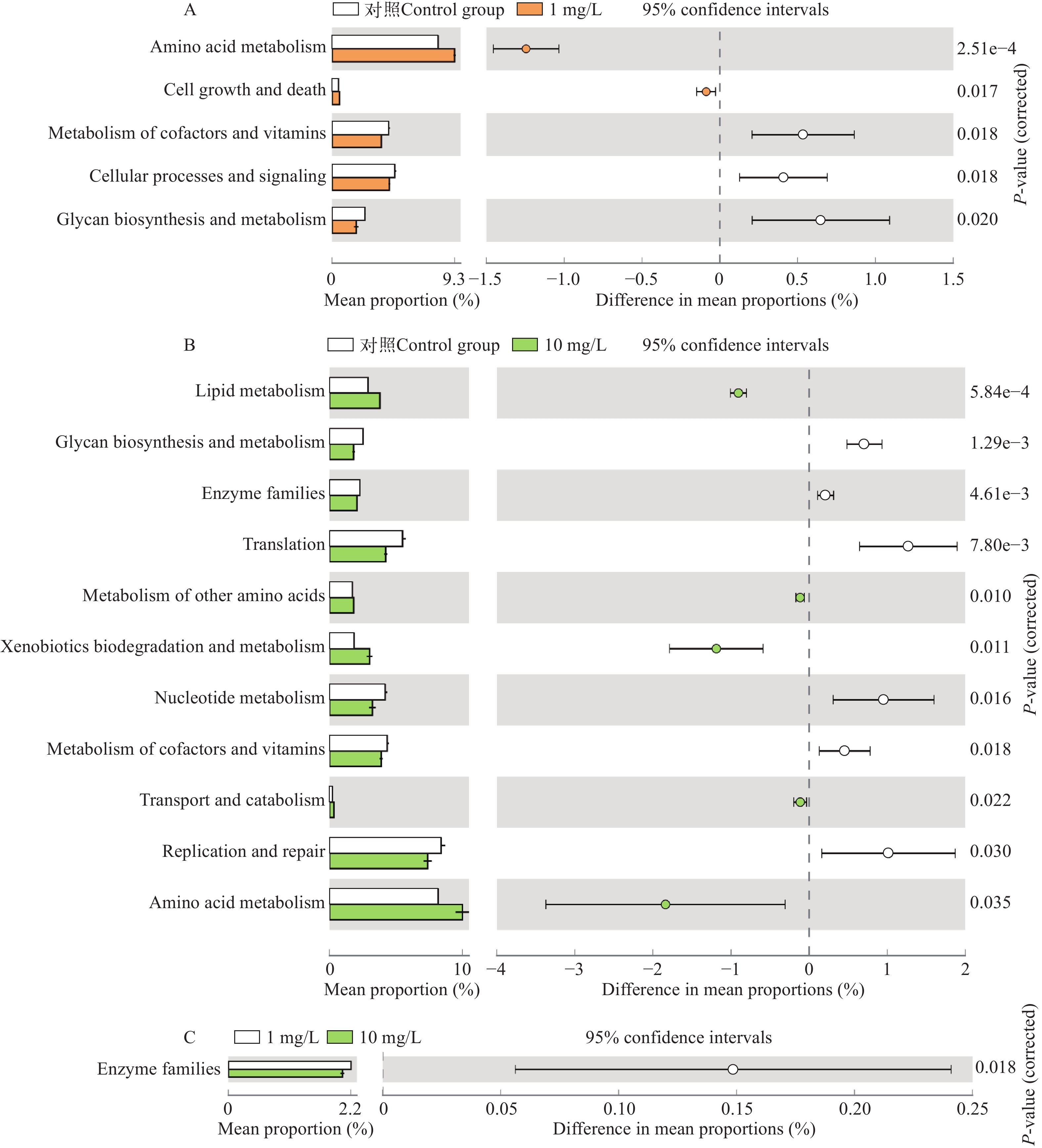PERFLUOROOCTANE SULFONATE (PFOS) ON INTESTINAL STRUCTURE AND MICROBIOTA OF ZEBRAFISH (DANIO RERIO)
-
摘要:
为探究全氟辛烷磺酸(Perfluorooctane sulfonate, PFOS)对鱼类的肠道毒性, 将雌雄斑马鱼分别暴露于0、1和10 mg/L的 PFOS中21d, 通过存活率、肠道组织切片、16S rRNA高通量测序、实时荧光定量PCR等技术检测斑马鱼肠道形态结构及微生物菌群的变化。结果表明: 暴露于10 mg/L PFOS的斑马鱼死亡率明显高于1 mg/L, 且对雄鱼的影响大于雌鱼。1 mg/L浓度组雌雄鱼的存活率分别为93.3%和83.3%, 而10 mg/L为33.3%和13.3%。1 mg/L PFOS暴露使斑马鱼的肠壁厚度轻微变薄、肠绒毛有破损的现象。10 mg/L浓度组肠壁厚度明显变薄, 肠绒毛高度降低、肠黏膜上皮细胞肿胀并伴随严重的溶解现象。PFOS暴露21d后, 肠道组织的炎症相关基因肿瘤坏死因子α (TNF-α)、白介素1β (IL-1β)和白介素10 (IL-10), 以及细胞凋亡相关基因胱天蛋白酶3 (Caspase 3)、p53、B淋巴细胞瘤-2 (Bcl2) 的表达量均显著高于对照组, 且Caspase3和p53基因在雄鱼的肠道的表达量显著高于雌鱼(P<0.05)。PFOS暴露显著增加了肠道菌群的多样性, 改变了肠道菌群结构。厚壁菌门(Firmicutes)、变形菌门(Proteobacteria)、放线菌门 (Actinobacteriota)和拟杆菌门(Bacteroidota)的相对丰度均显著增加, 而梭杆菌门(Fusobacteria)显著下降。在属水平, PFOS处理增加了罗尔斯通菌属(Ralstonia)和假单胞菌属(Pseudomonas)相对丰度, 而降低鲸杆菌属(Cetobacterium) 和气单胞菌属(Aeromonas)。两个处理组肠道菌中厚壁菌门/拟杆菌门(F/B)的比值高于对照组。PFOS处理增强了肠道菌群的氨基酸及脂代谢功能, 但削弱了聚糖的合成与代谢能力。综上所述, PFOS长期暴露会引起水生动物的肠道结构损伤及微生物菌群失调, 进而影响动物的健康。
-
关键词:
- 全氟辛烷磺酸(PFOS) /
- 肠道结构 /
- 微生物菌群 /
- 斑马鱼
Abstract:Perfluorooctane sulfonate (PFOS), as the main active component in anti-fouling agents used for textile and leather products, has been widely used in both industrial and daily settings. So far, PFOS contamination has been detected in groundwater, surface water, seawater, and even animal tissues. It exhibits notable toxicity to the liver, reproduction, development, and nervous system of fish; however, the effect on the fish intestine remain unclear. In this study, male and female zebrafish were exposed to 0, 1, and 10 mg/L of PFOS for 21d, respectively, and the changes in intestinal morphology, structure, and microflora of zebrafish were detected by survival rate, intestinal tissue section, 16S rRNA high-throughput sequencing, Real-time quantitative PCR, and other techniques. The results showed that zebrafish exposed to 10 mg/L PFOS had a significantly higher mortality rate than those exposed to 1 mg/L, with males being more affected than females. The survival rates of male and female fish in the 1 mg/L concentration group were 93.3% and 83.3%, while those in the 10 mg/L concentration group were 33.3% and 13.3%, respectively. Exposure to 1 mg/L PFOS led to a reduction in intestinal thickness and damage to intestinal villi. In the 10 mg/L group, the intestine was significantly thinner, villi height was reduced, and intestinal mucosal epithelial cells were swollen and accompanied by severe dissolution. After 21d PFOS exposure, the inflammation-related genes such as tumour necrosis factor-alpha (TNF-α), interleukin1beta (IL-1β), and interleukin10 (IL-10), along with caspase3, p53, and B-cell lymphoma-2 (Bcl2), were significantly higher than those of the control group. Furthermore, caspase3 and p53 expression in male intestines was significantly higher than those in females (P<0.05). PFOS exposure also significantly increased the diversity and altered the structure of gut microbiota, with a marked rise in the relative abundance of Firmicutes, Proteobacteria, Actinobacteriota, and Bacteroidota, and a significant decline in Fusobacteria. At the genus level, PFOS treatment increased the relative abundance of Ralstonia and Pseudomonas, but decreased Cetobacterium and Aeromonas. The Firmicutes/Bacteroidetes (F/B) ratio was higher in both treatment groups compared to the control group. Additionally, PFOS treatment increased the amino acid and lipid metabolism of the gut flora, but decreased the synthesis and metabolism of glycans. In conclusion, long-term PFOS exposure can lead to structure damage to the intestinal and dysbiosis in the microbial flora of aquatic animals, subsequently affecting their health.
-
Keywords:
- PFOS /
- Intestinal structure /
- Intestinal microbiota /
- Danio rerio
-
-
图 2 PFOS暴露对斑马鱼肠道显微结构的影响
黑色箭头标注的为肠壁; 灰色箭头标注的为肠道出现空泡化现象; 白色箭头标注的为肠绒毛出现破损现象
Figure 2. Effects of PFOS on intestinal microstructure in zebrafish
The black arrow indicates the intestinal wall; The gray arrow indicates the presence of vacuolation in the intestine; The white arrow indicates damage to the villi of intestine
表 1 试验中所用引物
Table 1 Primers used in this study
引物名称
Primer name引物序列
Primer sequences (5′—3′)用途
Usagerps11 ACAGAAATGCCCCTTCACTG 内参基因 GCCTCTTCTCAAAACGGTTG β-actin ATGGGCGTCCATGACCTTTT 内参基因 TGTACAGAGACACCCTGGCT TNF-α AGGAGAGTTGCCTTTACCGC qRT-PCR TGGCAGCCTTGGAAGTGAAA IL-1β AACGTCATCCAAGAGCGTGA qRT-PCR ACAGGCTGAGCAGAAGTAGC IL-10 CTCACGCTTCTTCTTTGCGAC qRT-PCR TCGTTCATGACGTGACATCCA Caspase 3 TCGGTTCTCGCTGTTGAAGG qRT-PCR ACCGCTTAACGAGCCCTTTT P53 AACCCAAATTCTGCGCAACG qRT-PCR ATCCAGTTTTCCAGTGGCCC Bcl2 CCTGGCGAACATTTGGAGGG qRT-PCR GCAACGTCCACCACCATTTG -
[1] Giesy J P, Kannan K. Global distribution of perfluorooctane sulfonate in wildlife [J]. Environmental Science & Technology, 2001, 35(7): 1339-1342.
[2] Ahrens L. Polyfluoroalkyl compounds in the aquatic environment: a review of their occurrence and fate [J]. Journal of Environmental Monitoring, 2011, 13(1): 20-31. doi: 10.1039/C0EM00373E
[3] Skutlarek D, Exner M, Färber H. Perfluorinated surfactants in surface and drinking waters [J]. Environmental Science and Pollution Research International, 2006, 13(5): 299-307.
[4] Tomy G T, Budakowski W, Halldorson T, et al. Fluorinated organic compounds in an eastern Arctic marine food web [J]. Environmental Science & Technology, 2004, 38(24): 6475-6481.
[5] Kurwadkar S, Dane J, Kanel S R, et al. Per- and polyfluoroalkyl substances in water and wastewater: a critical review of their global occurrence and distribution [J]. Science of the Total Environment, 2022(809): 151003.
[6] 武婷, 孙善伟, 樊境朴, 等. 不同年份太湖水域全氟化合物健康风险源解析对比 [J]. 环境科学, 2022, 43(9): 4513-4521.] Wu T, Sun S W, Fan J P, et al. Comparison of health risk from sources of perfluoroalkyl substances in Taihu Lake for different years [J]. Environmental Science, 2022, 43(9): 4513-4521. [
[7] Sun Z, Zhang C, Yan H, et al. Spatiotemporal distribution and potential sources of perfluoroalkyl acids in Huangpu River, Shanghai, China [J]. Chemosphere, 2017(174): 127-135. doi: 10.1016/j.chemosphere.2017.01.122
[8] Cui Q, Pan Y, Zhang H, et al. Elevated concentrations of perfluorohexanesulfonate and other per- and polyfluoroalkyl substances in Baiyangdian Lake (China): source characterization and exposure assessment [J]. Environmental Pollution, 2018(241): 684-691. doi: 10.1016/j.envpol.2018.05.099
[9] 宋娇娇, 汪艺梅, 孙静, 等. 沱江流域典型及新兴全氟/多氟化合物的污染特征及来源解析 [J]. 环境科学, 2022, 43(9): 4522-4531.] Song J J, Wang Y M, Sun J, et al. Pollution characteristics and source apportionment of typical and emerging per-and polyfluoroalkylated substances in Tuojiang River Basin [J]. Environmental Science, 2022, 43(9): 4522-4531. [
[10] Huang H, Huang C, Wang L, et al. Toxicity, uptake kinetics and behavior assessment in zebrafish embryos following exposure to perfluorooctanesulphonicacid (PFOS) [J]. Aquatic Toxicology, 2010, 98(2): 139-147. doi: 10.1016/j.aquatox.2010.02.003
[11] Hagenaars A, Knapen D, Meyer J, et al. Toxicity evaluation of perfluorooctane sulfonate (PFOS) in common carp (Cyprinus carpio): a systems biology approach [J]. Comparative Biochemistry and Physiology, Part A: Molecular & Integrative Physiology, 2008, 150 (3): S43.
[12] Olsen G W, Burris J M, Ehresman D J, et al. Half-life of serum elimination of perfluorooctanesulfonate, perfluorohexanesulfonate, and perfluorooctanoate in retired fluorochemical production workers [J]. Environmental Health Perspectives, 2007, 115(9): 1298-1305. doi: 10.1289/ehp.10009
[13] Lema S C, Schultz I R, Scholz N L, et al. Neural defects and cardiac arrhythmia in fish larvae following embryonic exposure to 2, 2’, 4, 4’-tetrabromodiphenyl ether (PBDE 47) [J]. Aquatic Toxicology, 2007, 82(4): 296-307.
[14] Ma T, Jiang Y, Chen P, et al. PFOS and PFOSA induce oxidative stress-mediated cardiac defects in zebrafish via PPARγ and AHR pathways, respectively [J]. Science of the Total Environment, 2024, 951: 175716. doi: 10.1016/j.scitotenv.2024.175716
[15] 潘伟一. PFOS和PFOA对斑马鱼的生物毒理效应及其风险评估研究 [Z]. 河北科技大学, 2019.] Pan W. Biotoxicological effects and risk assessment of zebrafish by PFOS and PFOA [Z]. Hebei University of Science and Technology, 2016. [
[16] 胡存丽, 仲来福. 全氟辛烷磺酸和全氟辛酸毒理学研究进展 [J]. 中国工业医学杂志, 2006, 19(6): 354-358.] doi: 10.3969/j.issn.1002-221X.2006.06.016 Hu C L, Zhong L F. Progress of toxicological study on PFOS and PFOA [J]. Chinese Journal of Industrial Medicine, 2006, 19(6): 354-358. [ doi: 10.3969/j.issn.1002-221X.2006.06.016
[17] Yukgehnaish K, Kumar P, Sivachandran P, et al. Gut microbiota metagenomics in aquaculture: factors influencing gut microbiome and its physiological role in fish [J]. Reviews in Aquaculture, 2020, 12(3): 1903-1927. doi: 10.1111/raq.12416
[18] Ma H, Williams P L, Diamond S A. Ecotoxicity of manufactured ZnO nanoparticles–A review [J]. Environmental Pollution, 2013(172): 76-85.
[19] Brugman S. The zebrafish as a model to study intestinal inflammation [J]. Developmental & Comparative Immunology, 2016(64): 82-92.
[20] Shi X, Du Y, Lam P K S, et al. Developmental toxicity and alteration of gene expression in zebrafish embryos exposed to PFOS [J]. Toxicology and Applied Pharmacology, 2008, 230(1): 23-32. doi: 10.1016/j.taap.2008.01.043
[21] 刘晓晖, 胡宏, 李双月, 等. 全氟辛烷磺酸神经发育毒性机制研究进展 [J]. 生态毒理学报, 2013, 8(5): 643-649.] doi: 10.7524/AJE.1673-5897.20130407001 Liu X H, Hu H, Li S Y, et al. Research progress on mechanisms in the developmental neurotoxicity of PFOS [J]. Asian Journal of Ecotoxicology, 2013, 8(5): 643-649. [ doi: 10.7524/AJE.1673-5897.20130407001
[22] 张越, 刘潇威, 张艳伟, 等. 不同浓度全氟辛烷磺酸对拟南芥叶片的代谢损伤机制 [J]. 农业环境科学学报, 2022, 41(9): 1897-1907.] doi: 10.11654/jaes.2022-0191 Zhang Y, Liu X W, Zhang Y W, et al. Metabolic damage mechanism of different concentrations of PFOS on Arabidopsis thaliana leaves [J]. Journal of Agro-Environment Science, 2022, 41(9): 1897-1907. [ doi: 10.11654/jaes.2022-0191
[23] Hansen K J, Johnson H O, Eldridge J S, et al. Quantitative characterization of trace levels of PFOS and PFOA in the Tennessee River [J]. Environmental Science & Technology, 2002, 36(8): 1681-1685.
[24] Niklasson L, Sundh H, Fridell F, et al. Disturbance of the intestinal mucosal immune system of farmed Atlantic salmon (Salmo salar), in response to long-term hypoxic conditions [J]. Fish & Shellfish Immunology, 2011, 31(6): 1072-1080.
[25] Chang X, Li H, Feng J, et al. Effects of cadmium exposure on the composition and diversity of the intestinal microbial community of common carp (Cyprinus carpio L.) [J]. Ecotoxicology and Environmental Safety, 2019(171): 92-98. doi: 10.1016/j.ecoenv.2018.12.066
[26] Chang X, Liu P, Feng J, et al. Impact of chronic exposure to the ionic liquid ([C8mim][PF6]) on intestinal physical barrier, immunological barrier and gut microbiota in common carp (Cyprinus carpio L.) [J]. Environmental Research, 2020(189): 109919. doi: 10.1016/j.envres.2020.109919
[27] Wang Y, Wang B, Wang Q, et al. Intestinal toxicity and microbial community disorder induced by bisphenol F and bisphenol S in zebrafish [J]. Chemosphere, 2021(280): 130711.
[28] Ankley G T, Kuehl D W, Kahl M D, et al. Reproductive and developmental toxicity and bioconcentration of perfluorooctanesulfonate in a partial life-cycle test with the fathead minnow (Pimephales promelas) [J]. Environmental Toxicology and Chemistry, 2005, 24(9): 2316-2324. doi: 10.1897/04-634R.1
[29] Opal S M, DePalo V A. Anti-inflammatory cytokines [J]. Chest, 2000, 117(4): 1162-1172. doi: 10.1378/chest.117.4.1162
[30] Zhang T, Yan Z, Zheng X, et al. Effects of acute ammonia toxicity on oxidative stress, DNA damage and apoptosis in digestive gland and gill of Asian clam (Corbicula fluminea) [J]. Fish & Shellfish Immunology, 2020(99): 514-525.
[31] Ho C J, Lin R W, Zhu W H, et al. Transcription-independent and-dependent p53-mediated apoptosis in response to genotoxic and non-genotoxic stress [J]. Cell Death Discovery, 2019(5): 131. doi: 10.1038/s41420-019-0211-5
[32] Choudhary G S, Al-harbi S, Almasan A. Caspase-3 Activation is a Critical Determinant of Genotoxic Stress-induced Apoptosis [M]. Methods in Molecular Biology. New York: Springer New York, 2014: 1-9.
[33] Tang D, Kang R, Vanden Berghe T, et al. The molecular machinery of regulated cell death [J]. Cell Research, 2019, 29(5): 347-364. doi: 10.1038/s41422-019-0164-5
[34] Tang L, Yu J, Zhuge S, et al. Oxidative stress and Cx43-mediated apoptosis are involved in PFOS-induced nephrotoxicity [J]. Toxicology, 2022(478): 153283.
[35] Ge J, Wang C, Nie X, et al. ROS-mediated apoptosis of HAPI microglia through p53signaling following PFOS exposure [J]. Environmental Toxicology and Pharmacology, 2016(46): 9-16. doi: 10.1016/j.etap.2016.06.025
[36] Bäckhed F, Manchester J K, Semenkovich C F, et al. Mechanisms underlying the resistance to diet-induced obesity in germ-free mice [J]. Proceedings of the National Academy of Sciences of the United States of America, 2007, 104(3): 979-984.
[37] Jin C, Luo T, Zhu Z, et al. Imazalil exposure induces gut microbiota dysbiosis and hepatic metabolism disorder in zebrafish [J]. Comparative Biochemistry and Physiology Part C: Toxicology & Pharmacology, 2017(202): 85-93.
[38] Adak A, Khan M R. An insight into gut microbiota and its functionalities [J]. Cellular and Molecular Life Sciences, 2019, 76(3): 473-493.
[39] Li Y, Wang Y, Han S, et al. N-acyl-homoserine lactones-mediated quorum sensing promotes intestinal colonization of Aeromonas veronii through facilitating cheA gene expression [J]. Aquaculture, 2024(579): 740189. doi: 10.1016/j.aquaculture.2023.740189
[40] Wan Z, Wang C, Zhou J, et al. Effects of polystyrene microplastics on the composition of the microbiome and metabolism in larval zebrafish [J]. Chemosphere, 2019(217): 646-658. doi: 10.1016/j.chemosphere.2018.11.070
[41] Turnbaugh P J, Hamady M, Yatsunenko T, et al. A core gut microbiome in obese and lean twins [J]. Nature, 2009, 457(7228): 480-484.
[42] Semova I, Carten J D, Stombaugh J, et al. Microbiota regulate intestinal absorption and metabolism of fatty acids in the zebrafish [J]. Cell Host & Microbe, 2012, 12(3): 277-288.
[43] Sylvain F É, Derome N. Vertically and horizontally transmitted microbial symbionts shape the gut microbiota ontogenesis of a skin-mucus feeding Discus fish progeny [J]. Scientific Reports, 2017, 7(1): 5263. doi: 10.1038/s41598-017-05662-w
[44] Wu Z Q, Jiang C, Ling F, et al. Effects of dietary supplementation of intestinal autochthonous bacteria on the innate immunity and disease resistance of grass carp (Ctenopharyngodon idellus) [J]. Aquaculture, 2015(438): 105-114. doi: 10.1016/j.aquaculture.2014.12.041
[45] 陈中义, 张杰, 黄大昉. 植物病害生防芽孢杆菌抗菌机制与遗传改良研究 [J]. 植物病理学报, 2003, 33(2): 97-103.] doi: 10.3321/j.issn:0412-0914.2003.02.001 Chen Z Y, Zhang J, Huang D F. Research progress on antimicrobial mechanism and genetic engineering of Bacillus for plant diseases biocontrol [J]. Acta Phytopathologica Sinica, 2003, 33(2): 97-103. [ doi: 10.3321/j.issn:0412-0914.2003.02.001
[46] 杨恩东, 崔丹曦, 汪维云. 马赛菌属细菌研究进展 [J]. 微生物学通报, 2019, 46(6): 1537-1548.] Yang E D, Cui D X, Wang W Y. Research progress on the genus Massilia [J]. Microbiology China, 2019, 46(6): 1537-1548. [
[47] 徐美余, 张瑶, 邓征宇, 等. 一株可裂解动物源性多重耐药志贺氏菌的噬菌体分离鉴定及其生物学特性研究 [J]. 微生物学杂志, 2023, 43(5): 91-100.] doi: 10.3969/j.issn.1005-7021.2023.05.010 Xu M Y, Zhang Y, Deng Z Y, et al. Isolation and biological characterization of a bacteriophage PSF26 that infects multidrug resistant shigella strains with animal origin splitting capability [J]. Journal of Microbiology, 2023, 43(5): 91-100. [ doi: 10.3969/j.issn.1005-7021.2023.05.010
[48] 武健. 黄单胞菌属病原菌对申嗪霉素及其吩嗪同系物耐药性机制研究 [D]. 南京: 南京农业大学, 2019.] Wu J. Tolerance mechanism of Xanthomonas spp. pathogens to phenazine-1-carboxylic acid and its phenazine homologues [D]. Nanjing: Nanjing Agricultural University, 2019. [
[49] 岳玲玲, 王梓潓, 李小芹, 等. 肠道菌群代谢物次级胆汁酸调控宿主免疫功能 [J]. 基础医学与临床, 2024, 44(6): 887-891.] Yue L L, Wang Z H, Li X Q, et al. Regulation of host immune function by gut microbiota-derived secondary bile acids [J]. Basic and Clinical Medicine, 2024, 44(6): 887-891. [
[50] 聂小燕, 林师庆, 何应沛, 等. 猪在不同阶段肠道微生物的变化及其对营养物质代谢的影响 [J]. 黑龙江畜牧兽医, 2022(11): 39-44.] Nie X Y, Lin S Q, He Y P, et al. Change of gut microbiota of pigs at different stages and its impact on host nutrition metabolism [J]. Heilongjiang Animal Science and Veterinary Medicine, 2022(11): 39-44. [



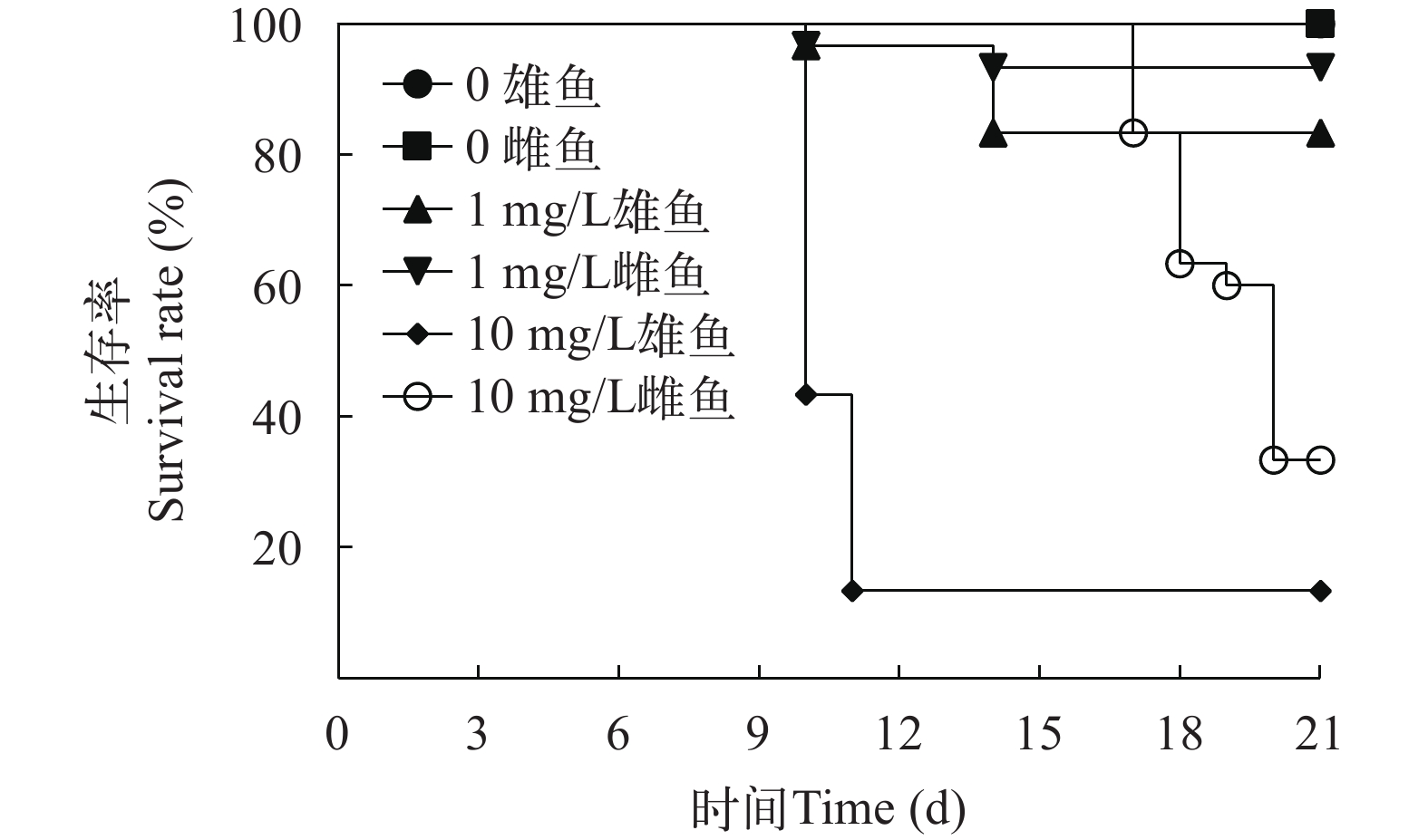
 下载:
下载:

